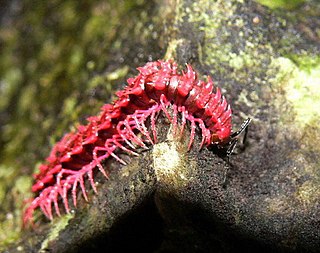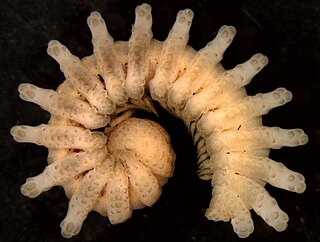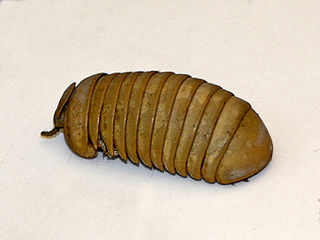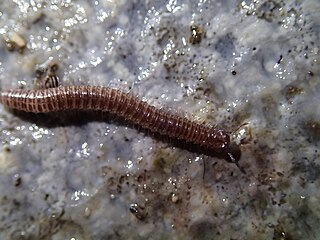
Desmoxytes, whose species are commonly known as the dragon millipedes, is a genus of millipedes of the family Paradoxosomatidae found in Southeast Asia. The genus was described by Ralph Vary Chamberlin in 1923, and reviewed by Sergei Golovatch and Henrik Enghoff in 1994. At least 18 species are known from to Malaysia, Myanmar, and Thailand. One species, D. planata, has also been observed in Sri Lanka, the Andaman Islands, Seychelles, Java, Great Coco Island, and Fiji; however, this species has expanded its range by being transported through human activity. Several species have only recently been discovered, and some have yet to be officially described.

Eutrichodesmus is a genus of millipedes in the family Haplodesmidae, containing at least 32 species in China, Taiwan, and Southeast Asia. One of these species exhibits sexual dimorphism in segments number: The adult females have 20 segments, but the adult males have only 19.

Richard Lawrence Hoffman was an American zoologist known as an international expert on millipedes, and a leading authority on the natural history of Virginia and the Appalachian Mountains. He was a biology professor at Virginia's Radford College for almost thirty years, and curator of invertebrates at the Virginia Museum of Natural History for another twenty years. He co-founded the Virginia Natural History Society, described over 400 species of millipedes, and produced more than 480 scientific publications. He is commemorated in the scientific and/or common names of over 30 animal species, including the valley and ridge salamander and Hoffman's dwarf centipede.

Orthomorpha is a genus of millipedes in the family Paradoxosomatidae containing approximately 50 species distributed in Southeast Asia.

Chordeumatida is a large order of millipedes containing some 1200 species with a nearly worldwide distribution. Also known as sausage millipedes, they grow and develop through a series of moults, adding segments until they reach a fixed number in the adult stage, which is usually the same for a given sex in a given species, at which point the moulting and the addition of segments and legs stop. This mode of development, known as teloanamorphosis, distinguishes this order from most other orders of millipedes, which usually continue to moult as adults, developing through either euanamorphosis or hemianamorphosis.

Casimir Albrecht Willem Jeekel (1922–2010) was a Dutch myriapodologist and entomologist known for his major contributions to the taxonomy of millipedes. His 1971 monograph Nomenclator Generum et Familiarum Diplopodorum is credited as launching the "modern era" of millipede taxonomy, and has been considered the "most important single work ever published on the Diplopoda". He served as director of the Zoological Museum Amsterdam, and authored over 150 works on the taxonomy of millipedes and other myriapods.

Ammodesmidae is a family of small millipedes endemic to Africa, containing seven species in two genera. Ammodesmids range from 1.4 to 5.0 mm long with 18 or 19 body segments in both sexes, and are capable of rolling into a tight sphere.

Zephronia is a genus of giant pill millipedes in the family Zephroniidae. This genus includes 47 species distributed throughout N. India, Myanmar, Thailand, Malayan Peninsula, Java, Sumatra and Borneo.

Trachysphaera is a genus of dwarf pill millipedes in the order Glomerida. Just over 30 species are known, making it the third most species-rich genus of Glomerida. Trachysphaera species are patchily distributed throughout Europe and western Asia, extending from Spain to Caucasia. Members of this genus are tiny, with modified appearances resembling that of calcareous stones.

Anoplodesmus is a genus of millipedes. It is one of the most species rich genera in the family Paradoxosomatidae, with over 40 described species distributed from India and Nepal to China and Southeast Asia, as well as the Mascarene Islands and Fiji.

Anamastigona is a genus of millipedes in the family Anthroleucosomatidae. There are about 20 described species in Anamastigona, found mainly in Europe and the Middle East.
Hyperglomeris is a genus of diplopods in the family Glomeridae.
Tonkinosoma is a genus of millipede in the family Paradoxosomatidae. The genus contains three species, with a new species discovered in 2018. Type species was described from northern Vietnam. Now the species are ranges from Himalayan region and southeast Asian region.
Underwoodia is a genus of millipedes in the family Caseyidae. There are at least three described species in Underwoodia.
Catharosoma is a genus of millipedes belonging to the family Paradoxosomatidae.
Cawjeekelia is a genus of millipedes belonging to the family Paradoxosomatidae.
Cleptomorpha is a genus of millipedes belonging to the family Paradoxosomatidae.
Kirkayakidae is a family of millipedes belonging to the order Chordeumatida. This family was formerly known as Altajellidae. Adult millipedes in this family have 28 segments rather than the 30 segments usually found in chordeumatidans.
Kashmireumatidae is a small family of millipedes belonging to the order Chordeumatida. These millipedes range from 5mm to 14mm in length and are found in East Asia. Adult millipedes in this family have only 26 or 28 segments rather than the 30 segments usually found in this order. In the species Vieteuma topali, adults have 26 segments, whereas in all other species in this family, adults have 28 segments.
Australeuma is a genus of Tasmanian millipede in the family Metopidiotrichidae.










